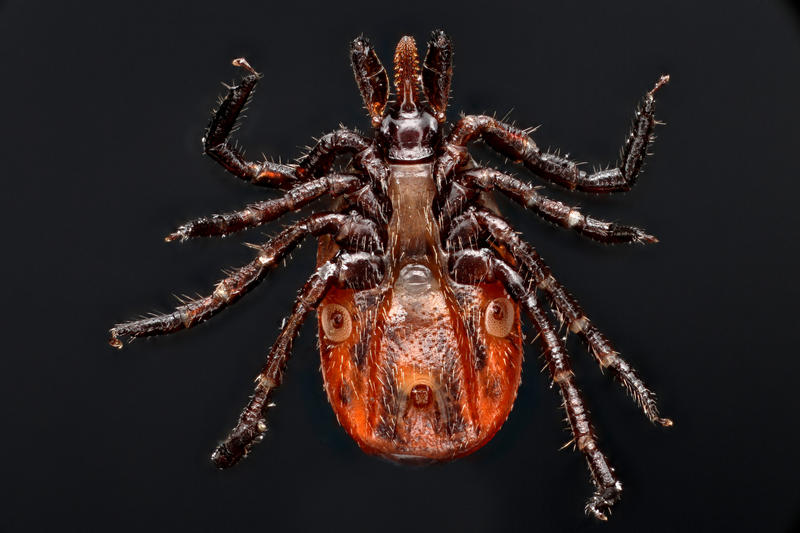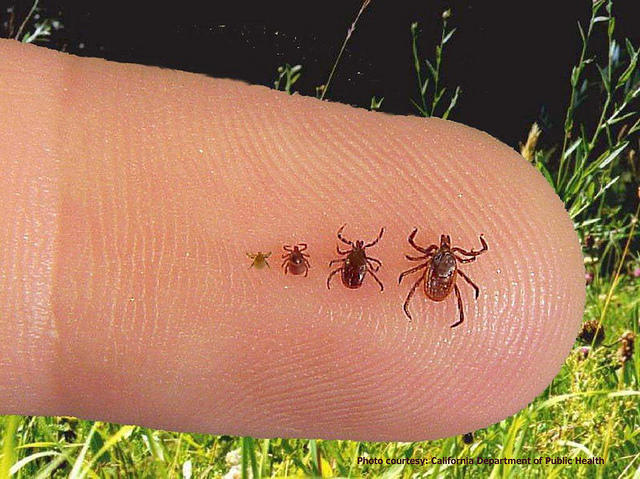http://adirondackexplorer.us5.list-manage.com/track/click?u=f2786fbb7862339a0b90113d7&id=e4358aed4b&e=46b8d98c61
The Summer Tick Forecast; New Ways to Fight Lyme Disease
By THE EXCHANGE • JUN 16, 2017
Ixodes scapularis, a blacklegged tick.
MACROSCOPIC SOLUTIONS / FLICKR/CC


Tick numbers are on the rise across New England this spring, raising the prospect of an increase in Lyme and other diseases associated with the blood suckers later this year.
The region got a respite last year as the drought took a toll on ticks, whose numbers drop as the humidity falls below 85 percent. But the drought is largely gone from the region and ticks are taking advantage.
Residents in Maine are complaining they are finding as many as 30 ticks at a time on their clothes, and public health officials in Vermont are reporting an above-average rate of emergency room visits for tick bites in the last three weeks.
“All of sudden everybody you know has got them,” said George Africa, owner of Vermont Flower Farm. He’s found two black-legged ticks on him in the last several weeks.
Alan Eaton, a tick expert with the University of New Hampshire Cooperative Extension, said the high numbers he has seen in New Hampshire are in line with what was expected, considering the high moisture levels and short dry periods.
“It’s a really bad year,” Eaton said.
On top of that, ticks have taken advantage of a proliferation in their favorite hosts, especially mice, chipmunks and other small rodents. But it isn’t so much the number of rodents this year that is critical.
Researchers from the Cary Institute of Ecosystem Studies, which for the past decade has studied ticks, found that a bevy of acorns one year can lead to a spike in Lyme-infected ticks two years later. They documented a bumper acorn crop in 2015 that resulted in an increase in small-rodent numbers a year later. As a result, they projected that 2017 would be especially bad for Lyme-disease ticks
http://nhpr.org/post/summer-tick-forecast-new-ways-fight-lyme-diseas
The Summer Tick Forecast & New
Ways to Fight Lyme Disease
By THE EXCHANGE • JUN 16, 2017

TOP LYME DISEASE RESEARCH DOCTORS FOR YOUR REFERENCE
- Dr. Benjamin Chan - state epidemiologist for New Hampshire’s Department of Health and Human Services.
- Alan Eaton - UNH Cooperative Extension Entomologist and Integrated Pest management Specialist. Alan has been studying ticks and Lyme disease in NH for three decades.
- Dr. Mark S. Klempner - Executive Vice Chancellor for MassBiologics of UMass Medical School and Professor of Medicine at the University at UMass Medical, where he's working on developing a treatment that could prevent people from getting Lyme disease.
- Richard Ostfeld - Disease Ecologist, Cary Institute of Ecosystem Studies, where he studies tick-borne disease ecology. .
- The NH Department of Health and Human Services provides fact sheets on tick bites, plus more information on Lyme disease in N.H., as well as Powassan virusand other tick-borne diseases.
- UNH Extension provides a publication that will help you learn what ticks look like, how they live, the diseases they spread, and how to protect yourself from tick-borne diseases.
- Read how biodiversity is a part of the fight against Lyme disease.
Learn more about tick-borne disease ecology from the Cary Institute of Ecosystem Studies, where guest Richard Ostfeld is a disease ecologist. He is also a part of The Tick Project, which is testing environmental interventions to prevent Lyme and other tick-borne diseases in upstate New York.

No comments:
Post a Comment